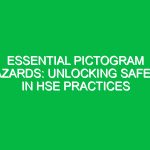# Preventing Dog Attacks: HSE Tips for a Safer Work Environment
Welcome, team! Today, we’re going to talk about an important topic that directly impacts our health, safety, and environment (HSE) at work: preventing dog attacks. While dogs are often considered man’s best friend, encounters with unfamiliar or aggressive dogs can pose serious risks. As we delve into this subject, let’s explore key strategies and best practices to ensure a safe work environment for all of us.
## Understanding Dog Attacks in the HSE Context
When we talk about dog attacks in the workplace, we’re not just referring to incidents involving pet dogs. Dog attacks can occur in various settings, including construction sites, delivery routes, or outdoor work environments where stray or unleashed dogs may be present. These attacks can result in injuries ranging from minor bites to severe wounds, posing a threat to our well-being and productivity.
## Recognizing Potential Hazards and Risks
Identifying potential hazards related to dog attacks is crucial for maintaining a safe work environment. Some common risks include:
– Unleashed or stray dogs in the vicinity
– Aggressive behavior from guard dogs or pets on the premises
– Lack of proper fencing or signage to alert workers about dog presence
– Inadequate training or awareness among employees on how to handle dog encounters
By recognizing these risks, we can proactively implement measures to prevent dog attacks and mitigate potential harm.
## Best Practices for Preventing Dog Attacks
To minimize the risk of dog attacks in the workplace, consider the following best practices:
1. **Awareness and Training:** Educate employees on how to identify signs of aggressive behavior in dogs and how to react appropriately. Training should include techniques for de-escalating confrontations and safely handling dog encounters.
2. **Secure Work Areas:** Implement physical barriers such as fences or gates to prevent unauthorized access by dogs. Ensure that warning signs are posted to alert employees and visitors about the presence of dogs on the premises.
3. **Personal Protective Equipment (PPE):** Provide employees with appropriate PPE, such as gloves or bite-resistant clothing, when working in areas where dog attacks are a potential risk.
4. **Reporting Protocols:** Establish clear procedures for reporting any dog-related incidents or near misses. Encourage open communication among team members to address safety concerns promptly.
5. **Collaboration with Local Authorities:** Work with animal control agencies or local authorities to address stray or aggressive dogs in the vicinity. Report any concerns about dangerous animals to the relevant authorities for immediate action.
## Real-Life Scenarios and Examples
Let’s consider a hypothetical scenario: During a routine delivery, a worker encounters an unleashed dog on the customer’s property. The dog exhibits aggressive behavior, barking and approaching the worker in a threatening manner. In this situation, the worker should:
– Remain calm and avoid making sudden movements
– Back away slowly while maintaining eye contact with the dog
– Use a barrier such as a package or bag to create distance between themselves and the dog
– Seek assistance from the customer or contact the supervisor for support
By following these guidelines, employees can effectively handle dog encounters and prevent potential attacks.
## Compliance with Regulations and Standards
In addition to internal policies and procedures, it’s essential to comply with relevant regulations and standards governing workplace safety. By adhering to guidelines set forth by occupational health and safety authorities, we can ensure a compliant and secure work environment for everyone.
## Conclusion
As we conclude this Toolbox Talk on preventing dog attacks, remember that safety is everyone’s responsibility. By staying vigilant, informed, and prepared, we can reduce the risk of incidents and create a safer work environment for all. Thank you for your attention and commitment to prioritizing health, safety, and environment in our daily operations. Let’s work together to prevent dog attacks and promote a culture of safety in our workplace.
Remember, safety first, always! Stay safe, team!
**Keywords**: toolbox talk, dog attacks, HSE, workplace safety, risk management.


